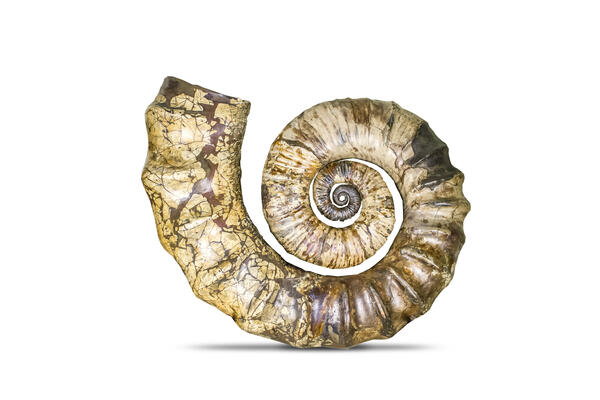Ammonites are fossil cephalopods with an outer shell. They appeared in all the seas and oceans of the Earth during the Devonian period, about 400 million years ago. They probably descended from the bactritoids, a group of straight-shelled cephalopods.
Modern scientists distinguish several hundred of their varieties, which differ greatly in appearance, habitat, and way of life. However, they all had a common feature: a spiral shell, which was divided into several chambers inside. The body of the mollusk was located in the last chamber: external or living. The remaining cavities were filled with water or air, depending on whether the mollusk sank to the bottom or moved closer to the surface.
The ammonites spent almost all their lives in the shell entirely. They put out only tentacles, a mouth, eyes, and a hypotone — a special tube through which water was pumped or pushed out.
The shells of various types of ammonites were externally very different. Some of them were small and smooth, while others were covered with many ridges and warts. In addition, representatives of the heteromorphs even resembled pieces of slightly curved wire: their shells often did not form curls at all.
Mollusks swam slowly; they most often were in the water column or drifted with the current. All the ammonites were predators, but they could only hunt prey who was not too fast: jellyfish, crabs, lobsters. The mollusks caught them with their tentacles and then captured them with jaws that looked like a sharp beak. Sharks, plesiosaurs, ichthyosaurs, mosasaurs, and other large marine animals often hunted them. Scientists were able to establish this by the teeth marks on the shells that have survived to this day. The mollusks did not know how to defend themselves from predators, and severe shell damage led to their death.
At the end of the Permian period — about 248 million years ago — almost all the ammonites became extinct. Only a few species survived, which gave rise to a new population. It settled in all waters from the South to the North Pole.
Ammonite shells are found on all continents. Sometimes they form massive accumulations in the form of ammonite limestones. As they are destroyed, ancient shells are washed out of them, which then carried by the currents. Therefore, they are often found on the shores of modern rivers and seas.
Modern scientists distinguish several hundred of their varieties, which differ greatly in appearance, habitat, and way of life. However, they all had a common feature: a spiral shell, which was divided into several chambers inside. The body of the mollusk was located in the last chamber: external or living. The remaining cavities were filled with water or air, depending on whether the mollusk sank to the bottom or moved closer to the surface.
The ammonites spent almost all their lives in the shell entirely. They put out only tentacles, a mouth, eyes, and a hypotone — a special tube through which water was pumped or pushed out.
The shells of various types of ammonites were externally very different. Some of them were small and smooth, while others were covered with many ridges and warts. In addition, representatives of the heteromorphs even resembled pieces of slightly curved wire: their shells often did not form curls at all.
Mollusks swam slowly; they most often were in the water column or drifted with the current. All the ammonites were predators, but they could only hunt prey who was not too fast: jellyfish, crabs, lobsters. The mollusks caught them with their tentacles and then captured them with jaws that looked like a sharp beak. Sharks, plesiosaurs, ichthyosaurs, mosasaurs, and other large marine animals often hunted them. Scientists were able to establish this by the teeth marks on the shells that have survived to this day. The mollusks did not know how to defend themselves from predators, and severe shell damage led to their death.
At the end of the Permian period — about 248 million years ago — almost all the ammonites became extinct. Only a few species survived, which gave rise to a new population. It settled in all waters from the South to the North Pole.
Ammonite shells are found on all continents. Sometimes they form massive accumulations in the form of ammonite limestones. As they are destroyed, ancient shells are washed out of them, which then carried by the currents. Therefore, they are often found on the shores of modern rivers and seas.



